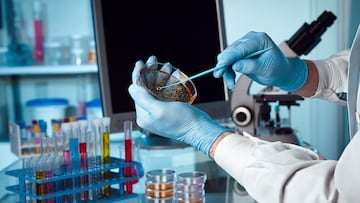Scientists discover new antibiotic to tackle most resistant bacteria: “There are incredibly interesting things hidden in plain sight”
Researchers found examples of a previously unknown antibiotic molecule in soil samples collected from a colleague’s garden.


Scientists from the Northeastern University in Boston, Massachusetts have discovered a new antibiotic molecule that could prove to be a game-changer in the fight against resistant bacteria.
The molecule is a species of Paenibacillus bacteria and has been found to boast real potency in some pathogens, including Escherichia coli (E-coli). With antibiotic-resistance bacteria becoming a growing concern to medicine, this latest breakthrough offers cause for real optimism.
Typically, bacteria mutates to develop resistance to drugs but the new molecule - named lariocidin by researchers - operates in a different way. Nature reports that it “targets bacteria’s protein-making factory, the ribosome, in a way that other antibiotic drugs don’t.” Researchers suspect that bacteria are less able to develop resistance against drugs that target the structure.
How was the new molecule discovered?
Bizarrely, the potentially life-saving molecule was discovered right beneath researchers’ feet. Gerry Wright, co-author of the study, and his team collected soil samples, introduced growth medium and kept them in storage for a year, before exposing them to E-coli microbes.
One of the soil samples - taken from a lab technician’s garden - displayed potent antibacterial activity and researchers were later able to identify the Paenibacillus bacteria as the source of the effect. Following a process of screening, genome sequencing and structural analysis, they were them able to use the lariocidin to treat mice that had been infected with Acinetobacter baumannii C0286. Mice treated with the newly-discovered molecule were able to survive the infection and recorded lower levels of bacteria in their bloodstream.
“As something that just came out of the ground, it’s pretty good,” Wright explained. “It’s a nice, really compact and incredibly robust structure.”
There is now real hope that this new molecule’s use can be broadened to deal with man-made compounds, like the bioweapon anthrax. Kim Lewis of the Antimicrobial Discovery Center at Northeastern University believes that, while anthrax can be modified to make it resistant to existing antibiotics, lariocidin might offer a solution.
“We can now borrow this sophisticated natural weapon to counter a human-engineered one,” Lewis explained. “The discovery of teixobactin changed the paradigm in the field of antibiotics... Where it is assumed there would be resistance to everything we could develop, that is no longer the case.”
Get your game on! Whether you’re into NFL touchdowns, NBA buzzer-beaters, world-class soccer goals, or MLB home runs, our app has it all.
Dive into live coverage, expert insights, breaking news, exclusive videos, and more – plus, stay updated on the latest in current affairs and entertainment. Download now for all-access coverage, right at your fingertips – anytime, anywhere.


Complete your personal details to comment
Your opinion will be published with first and last names